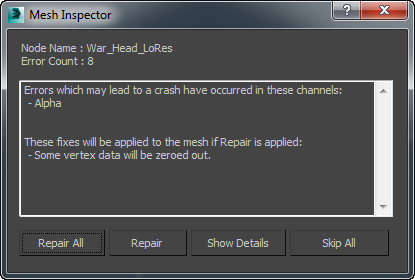Checks mesh geometry to be sure it is valid.
-
Note: The Mesh Inspector dialog appears only if errors are found, and only if Mesh Auto Repair is off.
The Mesh Inspector helps ensure the reliability of 3ds Max by checking the texture channels and topology of Editable Mesh and Editable Poly objects. When active, Mesh Inspector checks meshes when you:
- Open a scene file.
- Save a scene file.
- Change topology; for example, by using the stack to apply and adjust an Edit Poly modifier.
The Mesh Inspector looks for the following kinds of errors:
Level 1 errors:
- Unallocated texture map channels
- Unallocated texture face map channels
- Unallocated texture vertex map channels
- Not enough texture map faces allocated
- Out-of-bound array indices in a texture map channel
- Face degree mismatch (Poly meshes only) in a texture map channel
Level 2 errors:
- Bad vertex values such as 1/0 and +/– infinity
- References to dead structures
- Degenerate faces (Poly meshes only)
- Spur edges (Poly meshes only)
- No-degree faces (Poly meshes only)
Mesh Inspector runs two passes. It first checks for Level 1 errors and repairs these. Repairs to Level 1 errors don't require topology changes and are repaired silently. It then checks for Level 2 errors. Repairs to Level 2 errors require topology changes, and if you turn off Mesh Auto Repair, Mesh Inspector opens the Mesh Inspector dialog, which asks whether you want to make the repairs.
When Mesh Inspector is enabled and Mesh Auto Repair is on, Mesh Inspector repairs both Level 1 and Level 2 errors silently, and you do not see the Mesh Inspector dialog.
Interface

- Node Name
- Shows the name of the object with errors.
- Error Count
- Shows the number of errors found.
- [errors window]
- Describes the errors found.
- Repair All
- Click to repair all errors in the scene without further interaction.
- Repair
- Click to repair the current object. If other objects in the scene have errors, the Mesh inspector dialog will reappear.
- Show Details
- Click to open the
log file (
max.log)
to see more detailed error messages. Messages from the Mesh Inspector appear at the bottom of the log.
Note: In error messages in the log file, "NAN" stands for "not a number," and "MNMesh" stands for "Editable Poly."
- Skip All
- Click to leave all Level 2 errors uncorrected.
Note: Clicking
 (Close) to close the Mesh Inspector dialog skips corrections for the current object. If other objects in the scene have errors, the Mesh Inspector dialog will reappear.
(Close) to close the Mesh Inspector dialog skips corrections for the current object. If other objects in the scene have errors, the Mesh Inspector dialog will reappear.
